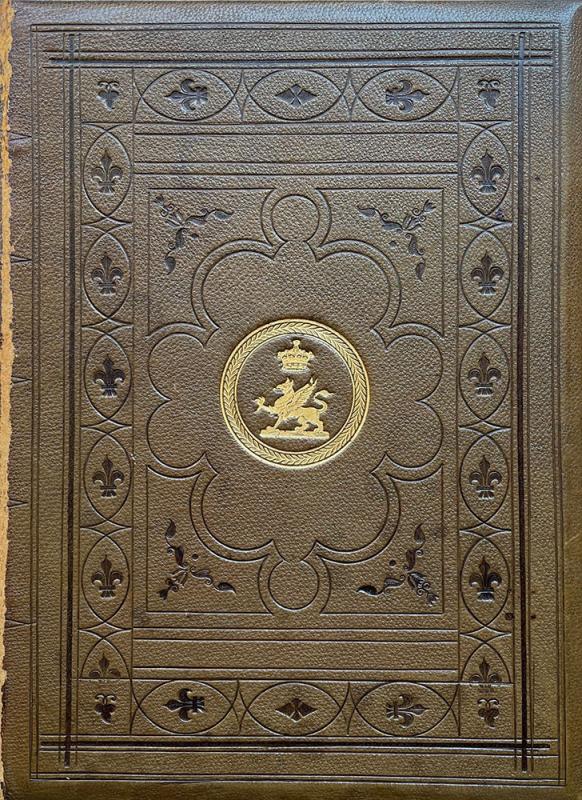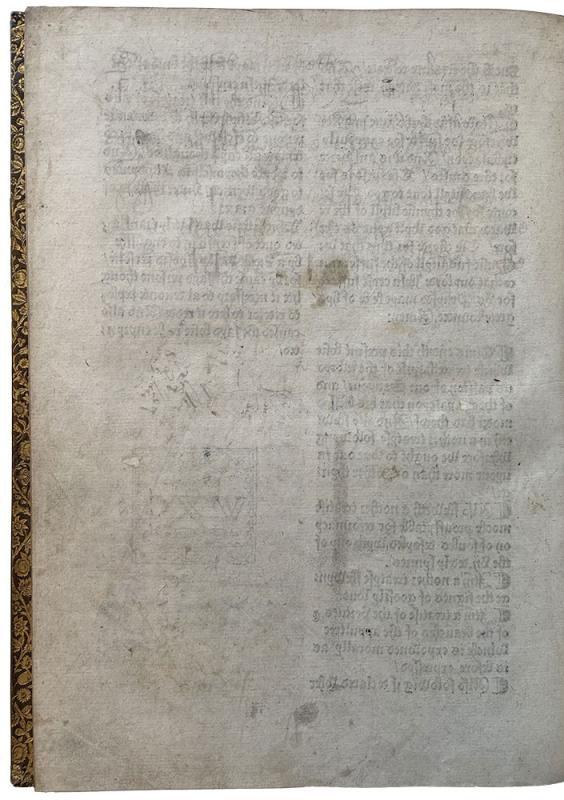
Manuscript title page by Randal Minshull, ca. 1700, in: Chastysing of Goddes Childern and Treatise of Love (Westminster: Wynkyn de Worde, 1492–1493). Purchased with the Amherst collection, 1908; PML 784.1–2, front endleaf.
One of the most interesting aspects of researching rare books is finding signs of use that a volume has accrued over the centuries. Ownership inscriptions, marginal annotations, bookplates, and bindings are all clues as to where a book has been and who has used it over its long life. A 500-year old book that looks like it has never been read is a perplexing problem.
Lately, I came across just such a volume, a copy of The Chastising of God’s Children bound with Treatise of Love, both printed at Westminster by Wynkyn de Worde in about 1492–93 (PML 784.1 and PML 784.2). The volume has an additional manuscript title page provided by Randal Minshull, the librarian to Edward Harley (1689–1761), 2nd Earl of Oxford.
Perplexing, however, is the 1744 sale catalogue of the Harley library, which describes this volume has having an early ownership inscription between two nuns:
“On the last Leaf, there is a Memorandum, written by a Nun of Campesey, named Elyzabeth Wyllowby, That she gives this Book to Dame Cateryne Symonde, under the Condition, That, in no wise, she sell it, or give it from the House of Campessey: But she shall give it to one of her Sisters.” (Catalogus Bibliothecae Harleianae, III, no. 1560)
The final leaf of Treatise of Love is blank...or at least, appears to be so. Ultraviolet light can often reveal ink inscriptions that are no longer visible to the human eye, and under ultraviolet light the erased inscription was more visible.
Even with digital enhancements, the inscription was still not fully legible; however, the names of the two nuns can be made out: “Elizabeth Willowby” and “dame Cateryne Symonde” are partially legible in the first and third lines. (The ascenders of the letters are particularly visible, as are the tails of the ys, which jut horizontally to the right.)
The leaf had been bleached—fading the inscription—when the volume was rebound for Heneage Finch (1786–1819), Fifth Earl of Aylesford.

Chastysing of Goddes Childern and Treatise of Love (Westminster: Wynkyn de Worde, 1492–1493). Purchased with the Amherst collection, 1908; PML 784.1–2, front cover.
Many 18th- and 19th-century book collectors often prized the “original” appearance of the book and had the inscriptions and marginal annotations added by previous readers and owners bleached away in order to recreate a pristine text. The inscription had literally vanished from sight. The Harley catalogue reference, however, has been repeatedly identified in literature on late medieval female reading and book ownership in England, which always cites the Willowby book as lost (see the brief bibliography below). What was lost, has now been found.
Elizabeth Willowby (or Willoughby) and Catherine Symond were both nuns at the Augustinian priory of Campsey in Suffolk (England). Both women are recorded at Campsey in 1514 and 1526. By 1532, Symond was the subprioress but Willowby no longer appeared in the list of nuns at the convent. The priory was dissolved by Henry VIII during the suppression of the monasteries in 1536. One of the remaining nuns, perhaps Symond herself, could have left with the book or else it was taken by the king’s agents confiscating the monastery’s property or sold off. Willowby owned another book, a manuscript including Walter Hilton's Scale of Perfection and the compilation The Seven Poyntes of True Love, now at the Parker Library, Corpus Christi College, Cambridge (MS. 268), which includes her partially abraded gift inscription on folio 169v: “M[emoran]d[um] that I Elizabeth wylby [(erased:) nonne of campessey] gyffe thys boke [rest of inscription cut away].” Elizabeth’s signatures in the Parker Library and Morgan Library volumes are remarkably similar. Even though there is no way to make the Morgan’s Willowby-Symond inscription once again visible on the page, a simple ultraviolet light and a smart phone picture have allowed us to find these two missing nuns after 200 years.
Select bibliography
Mary C. Erler, Women, Reading, and Piety in Late Medieval England (Cambridge: CUP, 2002), 125, with references to other literature. David N. Bell, What Nuns Read: Books and Libraries in Medieval English Nunneries (Kalamazoo, MI: Cistercian Publication, 1995), 123–26. N. R. Ker and Andrew G. Watson, Medieval Libraries of Great Britain: A List of Surviving Books (London: Offices of the Royal Historical Society, 1987), 28 and 238, see also Medieval Libraries of Great Britain online.
Images
All photos by author.
John T. McQuillen
Associate Curator, Printed Books & Bindings
The Morgan Library & Museum



